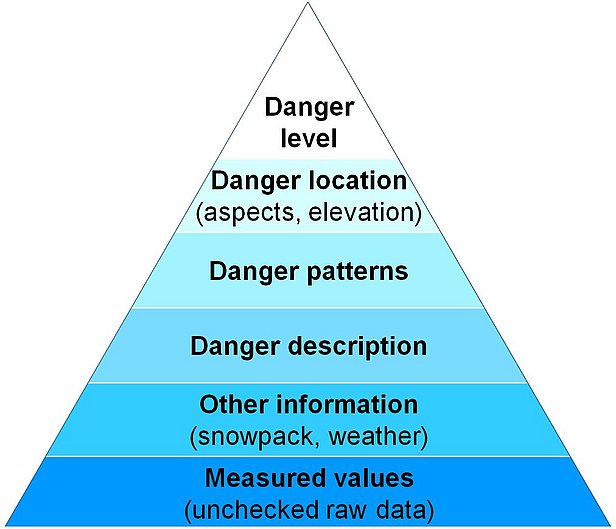The working group of the European Avalanche Warning Services consists of 29 avalanche warning services from 16 countries. It aims at developing common standards for the avalanche warning services in Europe and supporting the avalanche warning services in their work.
The benefit from this international cooperation to the user is in the common format of avalanche bulletins and in the assessment of the avalanche danger that follows comparable standards. Membership of the EAWS now extends to European countries beyond the Alps, such as Norway or Romania. A regular exchange with the avalanche warning services in the USA and Canada is maintained. The collaboration in the EAWS started in 1983.
Most important standards
1. Danger Scale
The principal achievement of the EAWS is the 5-point European Avalanche Danger Scale, which has been in use throughout Europe since 1994. The uniform scale is especially useful in regions close to national borders and for people who visit different countries. Ensuring its consistent application remains a constant task of the warning services. To promote it, a compendium of case studies from different countries is maintained that all the warning services assess and discuss. Furthermore, the regular exchange about the current avalanche situation during winter season is fostered, for example for the border triangle of Switzerland, Tyrol and South-Tyrol. Last but not least the warning services apply the commonly developed EAWS-Matrix.
2. Information pyramid
The content of the avalanche bulletins is in a common format everywhere: The information builds on each other like a pyramid from simple to complex (danger level – avalanche prone locations – avalanche problem – danger description – snowpack and weather – raw data). With increasing depth of information, the requirements for avalanche technical skills of the users increase.
3. Glossary
Harmonized terms simplify the comprehension. The glossary describes important terms – currently in nine languages.
4. Avalanche size classes
The common danger scale differentiates between five classes of avalanche sizes. These are specified in terms of damage potential, runout distance and mass. A harmonized application of the avalanche size classes is important, among other things, for the feedback information from the field.
5. Avalanche problems
The designation of the avalanche problems (new snow, snow drifts, old snow, wet avalanches, full-depth snowslides) in the avalanche bulletin helps to focus on the essence. Each avalanche problem has a different cause and requires adapted behaviour. A common application of the terms facilitates better comprehension of the users. The optional avalanche problems "cornices" and "no distinct avalanche problem" are now also part of the EAWS standards.
Organisation
During the General Assembly in June 2017, the EAWS also defined rules for ballots and elections, which lead to efficient decision making and the implementation thereof. Key positions are defined at the General Assemblies held every second year. For the period 2022 to 2025, key positions are as follows:
A) Chairpersons: Christine Pielmeier (CH) und Arnold Studeregger (AT)
The Chairs represent EAWS and are responsible for the organization and management of the General Assembly.
B) Coordinator: Thomas Feistl (DE)
The Coordinator leads the Technical Advisory Board and is responsible for the coordination and assistance of its working groups for an efficient operational speed. His responsibility is also to prepare and coordinate the subject matter of the General Assembly.
C) Technical Advisory Board
The Technical Advisory Board provides the leaders of the working groups. It discusses and decides upon suggestions of the working groups and upon the topics for submission to the vote of the General Assembly.
Members: Montserrat Bacardit (ES), Emma Barfod (NO), Igor Chiambretti (IT), Mark Diggins (GB), Anne Dufour (FR), Norbert Lanzanasto (AT), Christoph Mitterer (AT), Benjamin Zweifel (CH).
D) Membership Committee
The Membership Committee evaluates applications for membership and suggests positively evaluated applications to the General Assembly for admission to membership.
Members: Jürg Schweizer (CH), Rudi Mair (A), Gloria Marti (CAT), Ales Poredes (SI), Vincenzo Romeo (IT).
Member countries: France, Switzerland, Austria, Germany, Italy, Spain, Andorra, Finland, Great Britain, Iceland, Norway, Poland, Romania, Slovakia, Slovenia, Czech Republic

